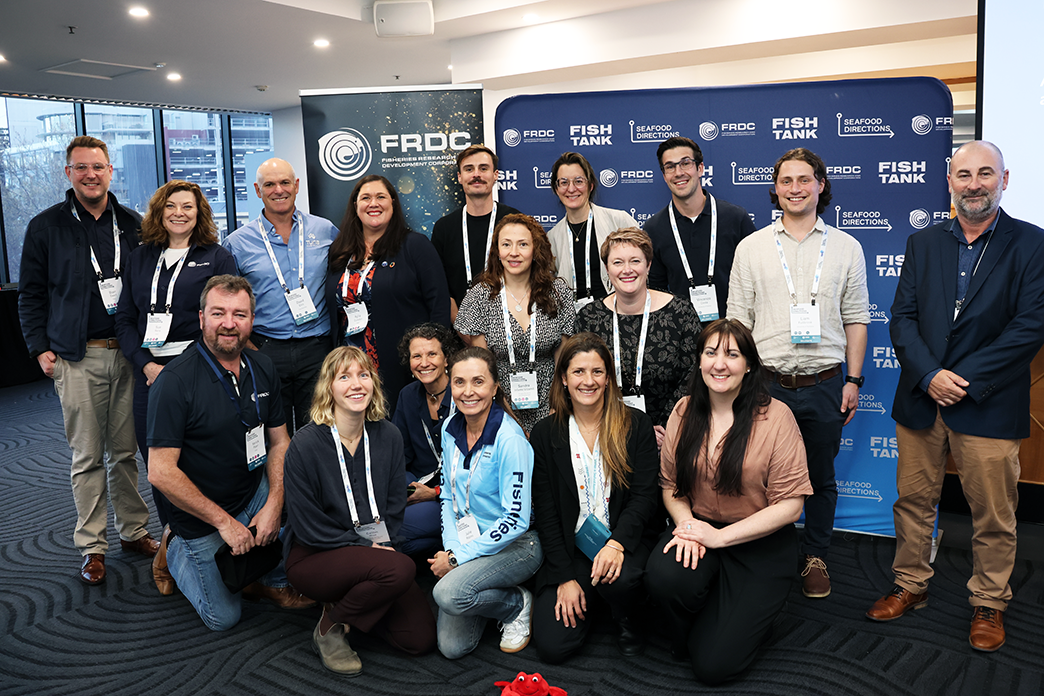On a clear, brisk day earlier this month, over 580 delegates were welcomed to Lutruwita (Tasmania) by a traditional and contemporary dance group - Pakana Kanaplila, for Seafood Directions 2024. Held in Hobart, this was the largest crowd ever, in the 25-year history of Seafood Directions.
Seafood Directions was established in 1999 as a Fisheries Research and Development Corporation (FRDC) initiative to provide an industry forum for the exchange of ideas and to showcase research. The outcomes from the conference are used to help address the challenges within our sectors and to help future-proof the businesses and people participating in fishing and aquaculture. In 2020, FRDC contracted Seafood Industry Australia (SIA) to convene the conference for the next three events, while FRDC continues to be heavily involved in planning, session selection and speakers for this important bi-annual event that benefits Australian fishing and aquaculture.

Before handing over to new Acting SIA Chair Catherine Sayer, outgoing Chair Clayton Nelson opened the conference with Olympian and Sports Administrator Nicole Livingstone OAM OLY, emceeing. The Minister for Agriculture, Fisheries and Forestry, the Hon Julie Collins MP, officially opened the event on behalf of the Commonwealth Government via a pre-recorded video.
There were more than 50 sessions held across the three-day event and over 30 of these showcased FRDC funded projects One of the highlights was an innovation in research presentation, FRDC’s FishTank, where eight exceptional research partners from across Australia brought their research to life in unique ways, including virtual reality experiences with artificial reefs, live demonstrations of how to prevent flyback while tuna longlining, jellyfish taste tests and even a climate-themed boardgame of (sea)snakes and ladders!
You can read more about these FishTank projects here.

FRDC was also a principal partner in the Women in Seafood Power-Up breakfast, attended by over 200 people. Special guest and keynote speaker Lucy Bloom entertained and inspired the audience, with an address that displayed both her vulnerability and determination to “take a chance” and take on ventures that make you “uncomfortable”.

As a testament to the business confidence within our fishing and aquaculture sectors, 20 exhibitors including FRDC, showcased their work through display booths that were staffed throughout the conference.

"Delegates were certainly spoiled for choice in what has been characterised as the “best ever” Seafood Directions."
While there were many informative sessions, a few of the highlights included:
Modernising fishery management & insights, a case study with the Spencer Gulf Prawn Association, with a panel consisting of Nathan Goss from Eratos, Ashley Lukin from Spencer Gulf Fishery and our very own, Kyaw Kyaw Soe Hlaing, FRDC General Manager ICT & Digitalisation. Ashley described how the eight skippers within the Spencer Gulf fishery share their aggregated data on fish size, catch volumes, quality, location, shore logistics, etc., to help them make fishery management decisions in real-time, while they’re on the water. While much of this fishing data is captured in the Deckhand platform, Nathan explained that Eratos is a data platform created to make it easier to find and use data a broad range of data – it can be collated, deidentified and if needed, used for analysis, research and forecasting, financing decisions, etc.
The Rethinking fishing for the future session related to two current FRDC projects 2023-154 Fish LIGHT- Low impact gears and innovative harvest technologies and 2023-155 Prawn trawl sea-snake bycatch reduction device – assessment, refinement and extension. Bryan van Wyk from Austral Fisheries, spoke from a fishers’ perspective and it was clear that he was passionate about trialing and adopting new gear technology to reduce bycatch.
Sam Willams from Queensland Department of Fisheries is involved in research to reduce bycatch to help retain fisheries and Kristin Hoel from Oceanwatch Australia, talked about how they collaborate with industry to better understand whale migration impacts from fisheries. Some of the technology discussed included the use of drones, satellites, underwater autonomous vehicles, lights instead of bait to attract fish, tunnel nets potentially replacing gill nets, smart buoys that brings gear to the surface and underwater GPS to help recover un-roped gear if it’s moved. All panellists agreed that fishers, researchers and environmental groups need to collaborate to find solutions and prove the science that will ultimately help lead to behaviour changes.
The session on Consumer Trends and Market Forces in Seafood, included an expert panel discussing seafood consumer trends and market forces. The diversity in the panellists reflected the different seafood purchasing categories – chefs, home diners, wholesalers, etc. Based on the experiences of the panellists, the range of drivers to buy seafood varied considerably (e.g. nutrition, sustainability, provenance), and through the discussion, it became increasingly clear that no ‘one size fits all’ when it comes to selling seafood. Importance was placed on aligning your value proposition (and marketing campaign) to your buyers and their expectations/motivations. The important (and often overlooked) role of seafood wholesalers as gatekeepers to consumers, was also identified, as a potential opportunity to leverage them to educate chefs and consumers on new/alternate seafood offerings.
During the conference, CSIRO conducted a series of foresighting workshops and in-depth interviews. Seafood producers, researchers, planners and retailers were asked to describe how the seafood industry would look in 2030, 2035 and 2040. They considered factors such as climate change, emergence of new industries (e.g. offshore energy, offshore aquaculture, carbon lock, blue mining), changes in market expectations, increases in cost structures, and changes in governance and technology. The results of the workshop will support marine ecosystem modelling aimed at identifying and measuring the likely impact of alternative futures on the Australian seafood sector. All findings will be made available through the Futures of Seafood on-line dashboard and a CSIRO published report.
With so many varied and interesting sessions, the most difficult part of attending Seafood Directions 2024 was trying to schedule which sessions to attend – delegates were certainly spoiled for choice in what has been characterised as the “best ever” Seafood Directions.






